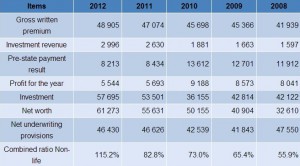The Korea National Insurance Corporation (KNIC) has a new web page that is internet accessible. Martyn Williams was the first to notice it. Although the web page offers information in English and Korean, I have only examined the English portal and I am unaware if there are significant differences between the two.
According to the web page:
KNIC, as a sole insurer of the DPR Korea has over 10 provincial insurance branches and over 200 insurance offices at municipal (district) and county levels under its umbrella nationwide and representative offices overseas.
The English web page provides basic financial and corporate information from 2008-2012. You can check out financial highlights, underwriting performance, and the consolidated balance sheet. It is unclear why 2013 and Q1 2014 data is not presented, but it is not like the shareholders or regulators are going to be up in arms about it.
On the corporate side we have a letter from the chairman of the executive management committee (since there are no shareholders he cannot be chairman of the board of directors)–again seeming to date from late 2012 or early 2013. We also see a list of the members of the executive management committee and an organization chart. The organization chart shows a list of internal divisions but does not explain how KNIC is linked to the cabinet.
KNIC posted a table of financial data (all numbers are in millions of KPW and cannot be verified):
The chart shows gross written premiums (총접수보험료) experienced an average growth of 16.6% (from 41,939m KPW to 48,905m KPW) between 2008 and 2012. Investment revenue (투자수입) also increased 87% (from 1,597m KPW to 2,996w KPW). Profits (순소득), however, fell 31% on average from 8,041m KPW in 2008 to 5,544m KPW in 2012. So over time, the firm has experienced increasing costs. I am not sure what these costs are, but if you love forensic accounting, please go through the financial reports and let me know.
The DPRK won experienced a significant loss in value compared to the US$ on the black market in 2012, falling from 4,400 to 9,100 per 1$. Using an annual average rate of 6,750 KPW to the US$, profits totaled just $821,333. Using the black market rate of 9,100, profits total $609,203. Using the official rate of 100KPW to the US$, profits grow to $55.44 million. Using the official Euro rate of 130KPW, profits total E42.64 million.
It is unclear what exactly “Pre-state payment result” (국가납부전 결과) is, but I believe it is the equivalent of “Earnings Before Taxes (EBT)” under Generally Accepted Accounting Principles (GAAP). Since the DPRK has officially abolished taxes, direct cash transfers to the state must take another name, so it appears to simply be “State Payment”, but it is definitely not “tax”.
“Profit for the year” listed for each year is .675 of the “Pre-state payment result” which tells us the unofficial tax rate on the firm is a flat 32.5% (1-.675) on net earnings.
It is unclear what happens with profits in these firms. In privately owned firms in capitalist countries, profits are generally reinvested in the business or distributed as dividends to shareholders, partners, or proprietors.
Moving on to the corporate side, the web site lists the following major operational departments:
1. Property Insurance Department is in charge of non-life insurance classes, such as property, crop, livestock, engineering and motor applied from institutions, enterprises, cooperatives and individual citizens.
2. Marine Insurance Department handles such lines as marine hull, cargo and liability, aviation hull and liability applied from institutions, enterprises and cooperatives.
3. Life Insurance Department provides life and personal accident coverage applied from institutions, enterprises, cooperatives and individual citizens.
4. Economic Cooperation Insurance Department offers different classes of insurance to newly developed economic zones and foreign invested enterprises (foreigners, joint ventures, representative offices, correspondent branch offices, embassies and international organizations) including Rason Economic and Trade Zone and Hwanggumphyong and Wihua Islet Economic Zone.
5. Reinsurance Department organizes reinsurance protection for primary insurance accounts written by KNIC. This department has a bad reputation in the west.
6. Investment Department conducts investment activities into financial securities and mining, and manages non-insurance enterprises like a shipping company.
7. Additional divisions: Market Research, Insurance Cooperation, Financial Supervision, Finance & Accounting, Administration and Protocol, all of which are engaged in their respective functions.

